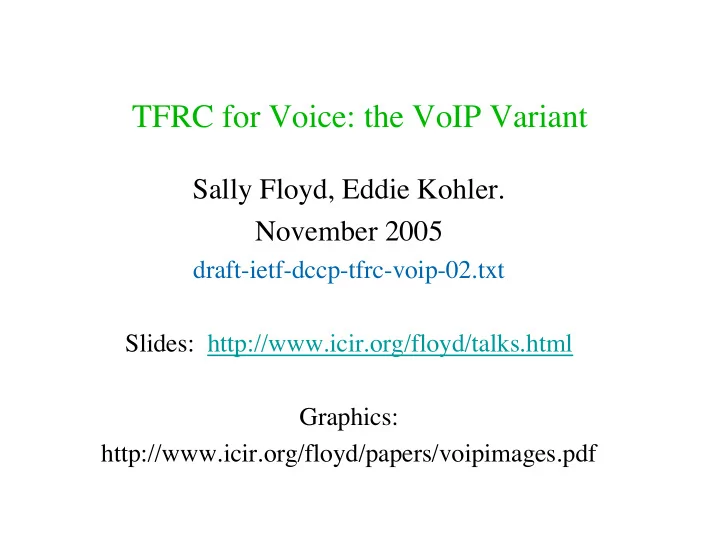

TFRC for Voice: the VoIP Variant Sally Floyd, Eddie Kohler. November 2005 draft-ietf-dccp-tfrc-voip-02.txt Slides: http://www.icir.org/floyd/talks.html Graphics: http://www.icir.org/floyd/papers/voipimages.pdf
VoIP: fairness in Bps. • In the TCP throughput equation, use the measured loss event rate and a packet size of 1460 bytes. • Reduce the allowed transmit rate to account for the fraction of the VoIP bandwidth that would be used by 40-byte headers: • Enforce a Min Interval between packets of 10 ms. • For short loss intervals (at most two RTTs), count the actual packet loss rate (but don’t increase the number of loss intervals).
Report from the last IETF: Issues remaining • The problem: – VoIP TFRC, with small packets, can see different packet drops that it would have with larger packets. When is this a problem? • For simulations with configured byte drop rates (where small packets are less likely to be dropped than large packets): – When compared with 1460-byte TCP, even standard TFRC with small packets can get much more than its share of the bandwidth in times of high congestion.
The status for TFRC using small packets: • Configured *packet* drop rates: – Standard TFRC with small packets doesn’t do well; – VoIP TFRC with small packets achieves reasonable fairness with large-packet TCP. • Configured *byte* drop rates: – With byte drop rates, TCP sometimes does better with smaller packets. – Standard TFRC with small packets achieves reasonable fairness with TCP using the optimal packet size for that level of congestion. – VoIP TFRC with small packets achieves more bandwidth than TCP using optimal packet sizes.
Configured *packet* drop rates, with 200-byte TFRC segments, 1460-byte TCP segments:
Configured *byte* drop rates, with 14-byte TFRC segments, 1460-byte TCP segments:
Configured *byte* drop rates, with 14-byte TFRC segments, “optimal” TCP segment sizes:
Question from last time, and an answer: • Is it ok to have congestion control for small-packet flows that lets small-packet flows receive more bandwidth than large-packet TCP flows in environments where small packets are less likely to be dropped than large ones? • Answer: I think so, as an Experimental CCID. It seems that for many paths in the Internet, small packets don’t receive favorable treatment.
Drop rates with different packet sizes: Downloads from web servers, from Alberto Medina. Annotation: total # of drops / total # of packets
Recommend
More recommend